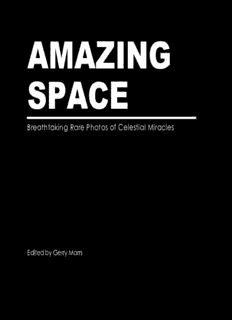
Amazing Space PDF
Preview Amazing Space
AMAZING SPACE Breathtaking Rare Photos of Celestial Miracles Edited by Gerry Marrs © 2016 Gerry Marrs Cover design by Gerry Marrs, Twin Jet Nebula All photos have been enhanced and altered for use in this textbook. First edition, 2016 ISBN-13: 978-1539828808 ISBN-10: 1539828808 2. Part 1 – Nebula What is a nebula? Some of you might think of one in terms of a lighted cloud in space, creating beautiful illusions that accents the stars behind it. You might be basing your beliefs about certain science fiction movies where these gas disturbances can wreak havoc on subspace communications and various sensors on board the spacecraft. Regardless of what your preconceived notions about nebula actually are, one fact is certain. No one living, as of yet, has actually been up close to one to relay their experiences. That is left up to distant observation from afar and years of research experience regarding the known universe and physics. A nebula is comprised of interstellar dust, hydrogen, helium and several ionized gases. Most nebulae are of vast size, even up to millions of light years in diameter. While it was imagined by the public that nebula consisted of a thick cloud of active electromagnetic activity, in reality, if one were close enough to actually touch the material, it would only be a slightly glowing mass of gaseous material that would be barely visible. They glow only because of their embedded stars illuminating their wondrous expanse from within. Some of these nebula (or plural, nebulae) are clustered in regions of space where brand new stars are being formed. In other cases, nebulae are the results of a dead star. You will see some incredible pictures and examples of a nebula in the next several pages and all were photographed and measured by NASA special instruments. 3. Several different types of nebula have been categorized. Planetary nebula is typically an expanding shell of ionized gas emitted from dying red giant stars. They received their name as a result of astronomer William Herschel (1738 – 1822) believing that they were planets due to their round shape when viewed through a telescope. Globular Clusters These consist mainly of old stars. Globular clusters aren't focused in the plane of the galaxy but rather, are randomly distributed through the halo. There are several hundred globular clusters associated with our own galaxy. A normal globular cluster is a few hundred light-years across. Open Clusters Open clusters are loose aggregations of hundreds or dozens of young stars. They can are usually not bound and will disperse in a relatively brief period of time. They may be often associated with more diffuse nebulae. Additionally, these are sometimes called "galactic clusters" because they may be normally present in the plane of a galaxy. A typical open cluster is less than 50 light years across. 4. Emission Nebulae Emission nebulae are clouds of high temperature gas. Emission nebulae are often the sites of on-going star formations. Reflection Nebulae Reflection nebulae are clouds of dust which are merely reflecting the light of a nearby star or stars. Reflection nebulae are also generally sites of star formation. They are generally blue because the scattering is more efficient for blue light. Emission nebulae and reflection nebulae in many cases are seen together and are occasionally both called diffuse nebulae. Dark Nebulae Dark nebulae are clouds of dust which are just blocking the light from whatever is behind. They are physically much the same to reflection nebulae; they appear different only due to the geometry of the light source, the cloud and the Earth. Dark nebulae can also be frequently seen in conjunction with reflection and emission nebulae. A typical diffuse nebula is a few hundred light years across. Supernova Remnants Supernovae occur when a massive star ends its life within an amazing blaze of glory. For a few days, a supernova emits as much energy as a whole galaxy. A large fraction of the star is blown into space as a supernova remnant when it is all over. A typical supernova remnant is a few light years across. 5. The next section details the breath-taking images captured by such famous space telescopes as Hubble and the Spitzer Telescope. 6. 7. PLATE 1: The Twin Jet Nebula, or PN M2-9, is a striking example of a bipolar planetary nebula. Bipolar planetary nebulae are formed when the central object is not a single star, but a binary system, Studies have shown that the nebula’s size increases with time, and measurements of this rate of increase suggest that the stellar outburst that formed the lobes occurred just 1200 years ago. 8. 9. PLATE 2: The Dumbbell nebula, also known as Messier 27, pumps out infrared light in this image from NASA Spitzer Space Telescope. Planetary nebulae are now known to be the remains of stars that once looked a lot like our sun.
Description: